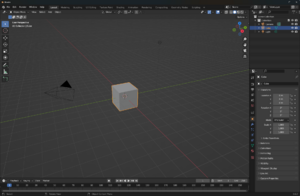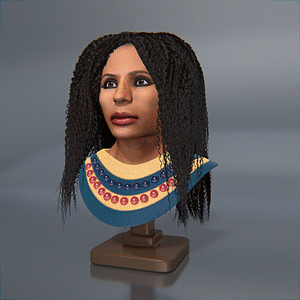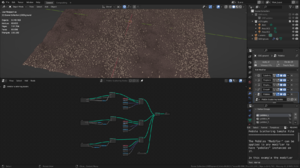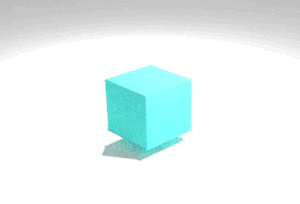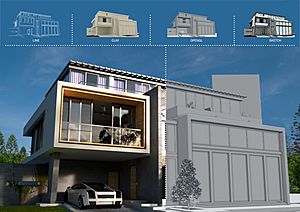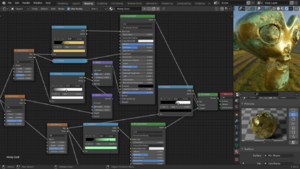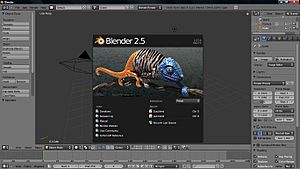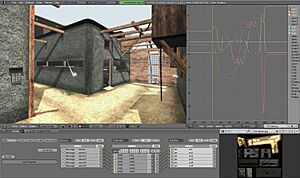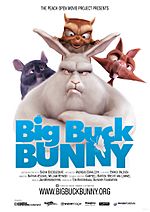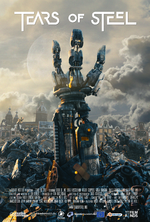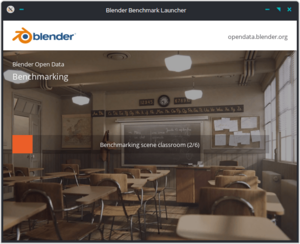Blender (software) facts for kids
 |
|

Screenshot of Blender 4.5.1
|
|
| Original author(s) | Ton Roosendaal |
|---|---|
| Developer(s) | Blender Foundation, community |
| Initial release | January 2, 1994 |
| Stable release | |
| Preview release |
4.5.0 / May 2, 2025
|
| Written in | C++, Python |
| Operating system | Linux, macOS, Windows, IRIX, BSD, Haiku |
| Size | 290–397 MiB (varies by operating system) |
| Available in | 36 languages |
|
List of languages
Abkhaz, Arabic, Basque, Brazilian Portuguese, Castilian Spanish, Catalan, Croatian, Czech, Dutch, English (official), Esperanto, French, German, Hausa, Hebrew, Hindi, Hungarian, Indonesian, Italian, Japanese, Korean, Kyrgyz, Persian, Polish, Portuguese, Romanian, Russian, Serbian, Simplified Chinese, Slovak, Spanish, Swedish, Thai, Traditional Chinese, Turkish, Ukrainian, Vietnamese
|
|
| Type | 3D computer graphics software |
| License | GPL-2.0 or later |
Blender is a free and open-source software tool. It helps you create amazing 3D computer graphics. You can use Blender on many computer systems like Windows, macOS, and Linux.
People use Blender to make animated movies, cool visual effects, and digital art. It's also great for designing models for 3D printers. You can even create interactive 3D apps and virtual reality experiences. Blender is also used to make video games.
A film called Flow (2024) won an Academy Award and was made using Blender.
Contents
- Blender's Story: How It Started
- Meet Suzanne: Blender's Monkey Head
- What Blender Can Do
- Supported File Types
- How to Use Blender: The Interface
- Blender's Development Journey
- Getting Help with Blender
- Blender in Movies and Games
- Blender in Schools and Research
- Blender's Creative Projects
- Blender Online Services
- Blender's Release History
- More to Explore
- See also
Blender's Story: How It Started
Blender began as a special tool for an animation studio in the Netherlands called NeoGeo. It officially launched on January 2, 1994. The main creator was Ton Roosendaal, who was a co-owner and software developer.
The name Blender came from a song by the band Yello. This song was used in NeoGeo's demo reel. Some ideas for Blender came from an older program called Traces. Ton Roosendaal had developed Traces for the Commodore Amiga computer.
In 1998, Blender became available online for free. Later, NeoGeo closed down. Ton Roosendaal then started a new company, Not a Number Technologies (NaN), to keep developing Blender. At first, it was sold as shareware, but NaN went bankrupt in 2002. This stopped Blender's development for a short time.
In May 2002, Roosendaal created the non-profit Blender Foundation. Their main goal was to continue developing Blender as a free, open-source project. They started a campaign to raise money to make Blender's source code free for everyone. They reached their goal, and on September 7, 2002, Blender became free and open-source. Today, many people in the community and employees of the Blender Institute help improve Blender.
Meet Suzanne: Blender's Monkey Head
In February 2002, the company that made Blender, NaN, was about to close. Before it did, they released Blender 2.25. As a fun "Easter egg", the artists added a 3D model of a chimpanzee head. They called it "monkey" in the software.
It was created by Willem-Paul van Overbruggen. He named it Suzanne after an orangutan in the film Jay and Silent Bob Strike Back.
Suzanne is like a special test model for Blender users. Other programs have models like the Utah Teapot. Suzanne is a low-polygon model with only 967 faces. It's often used to quickly test materials, animations, and lighting. You can find it as a basic shape, just like cubes or planes.
The biggest Blender contest even gives out an award called the Suzanne Award. This shows how important this monkey head is to the Blender community!
What Blender Can Do
Creating 3D Models
Blender supports many basic shapes. These include polygon meshes, Bézier curves, and text. It also has an advanced polygonal modeling system. This system lets you do things like "extrude" (pull out parts) and "bevel" (round edges).
Modifiers: Special Effects for Models
Modifiers add different effects to your models. These effects don't permanently change the model. They can be applied when you render or export your work. Examples include making surfaces smoother or adding thickness.
Sculpting: Shaping Digital Clay
Blender lets you sculpt digital models. It's like working with clay. You can add details, smooth surfaces, and reshape your models. This is useful for making complex characters or objects.
Geometry Nodes: Building with Rules
Blender has a system called Geometry Nodes. It lets you create and change shapes using a visual graph. This means you can build complex scenes with rules. For example, you can scatter many objects across a surface. This system was added in Blender 2.92. It helps you create things without changing the original model.
Simulating Real-World Physics
Blender can simulate many real-world effects. It can show smoke, rain, dust, and even cloth moving. It also simulates how liquids and solid objects behave.
Fluid Simulation: Making Water Flow
The fluid simulator can show liquids like water pouring into a cup. It uses special methods to make fluids look realistic. You can adjust how particles and resolution work.
Blender also has tools for soft bodies and rigid bodies. It can create ocean waves and particle systems for hair.
In Blender 2.82, a new fluid system called Mantaflow was added. It replaced the older system. Blender 2.92 added another system called APIC. This improved how vortices look and made calculations more stable.
Cloth Simulation: Realistic Fabric
Cloth simulation makes fabric look real. It works by simulating how points on a 3D model move. This creates effects similar to soft body simulations.
Bringing Models to Life with Animation
Blender has many tools for animation. You can make characters move using "armatures" (like skeletons). You can also create different shapes for objects to change over time. Blender's Grease Pencil tools let you do 2D animation. This means you can draw directly in a 3D space.
Rendering: Making Your Art Look Real
Blender has three main render engines since version 2.80: EEVEE, Workbench, and Cycles.
Cycles is a "path tracing" render engine. It creates very realistic images. It can use your computer's CPU or GPU to render.
EEVEE is a real-time renderer. It's fast and great for seeing your work as you create it. It can also be used for final images.
Workbench is for quick previews. It helps you see your model while you are working on it. It's not for final, high-quality renders.
Cycles: The Realistic Renderer
Cycles is a powerful render engine. It's designed to be easy to use but still has many features. It was added to Blender in 2011. Cycles can use modern computer hardware to speed up rendering.
Using Your Graphics Card (GPU) for Rendering
Cycles can use your computer's graphics card (GPU) to render faster. There are different ways to do this, depending on your graphics card. For example, Nvidia cards use CUDA or OptiX. AMD cards use HIP, and Intel cards use oneAPI.
You can even use multiple GPUs to render faster. This is like having a "render farm" on your computer. It helps process frames or parts of images at the same time.
Apple computers with M1 chips and AMD graphics cards also have support for Cycles.
| Feature | CPU | CUDA | OPTIX | HIP | oneAPI | Metal | ||||||||||||||||||||||||||||||||||||||||||||||||||||||||||||
|---|---|---|---|---|---|---|---|---|---|---|---|---|---|---|---|---|---|---|---|---|---|---|---|---|---|---|---|---|---|---|---|---|---|---|---|---|---|---|---|---|---|---|---|---|---|---|---|---|---|---|---|---|---|---|---|---|---|---|---|---|---|---|---|---|---|---|
| Hardware Minimum for 3.0 | x86-64 and other 64-Bit | Cuda 3.0+: Nvidia cards Kepler to Ampere (CUDA Toolkit 11.1+) | OptiX 7.3 with driver 470+: Full: Nvidia RTX Series; Parts: Maxwell+ | AMD RDNA architecture or newer, Radeon Software Drivers (Windows, Linux) | Intel Graphics Driver 30.0.101.3430 or newer on Windows, OpenCL runtime 22.10.23904 on Linux | Apple Computers with Apple Silicon in MacOS 12.2, AMD Graphics Cards with MacOS 12.3 | ||||||||||||||||||||||||||||||||||||||||||||||||||||||||||||
| Basic shading | Yes | Yes | Yes | Yes | Yes | Yes | ||||||||||||||||||||||||||||||||||||||||||||||||||||||||||||
| Shadows | Yes | Yes | Yes | Yes | Yes | Yes | ||||||||||||||||||||||||||||||||||||||||||||||||||||||||||||
| Motion blur | Yes | Yes | Yes | Yes | Yes | Yes | ||||||||||||||||||||||||||||||||||||||||||||||||||||||||||||
| Hair | Yes | Yes | Yes | Yes | Yes | Yes | ||||||||||||||||||||||||||||||||||||||||||||||||||||||||||||
| Volume | Yes | Yes | Yes | Yes | Yes | Yes | ||||||||||||||||||||||||||||||||||||||||||||||||||||||||||||
| Subsurface scattering | Yes | Yes | Yes | Yes | Yes | Yes | ||||||||||||||||||||||||||||||||||||||||||||||||||||||||||||
| Open Shading Language (1.11) (OSL 1.12.6 in 3.4) | Yes | No | Partial | No | No | No | ||||||||||||||||||||||||||||||||||||||||||||||||||||||||||||
| Correlated multi-jittered sampling | Yes | Yes | Yes | Yes | Yes | Yes | ||||||||||||||||||||||||||||||||||||||||||||||||||||||||||||
| Bevel and AO shaders | Yes | Yes | Yes | Yes | Yes | Yes | ||||||||||||||||||||||||||||||||||||||||||||||||||||||||||||
| Baking | Yes | Yes | Yes | Yes | Yes | Yes | ||||||||||||||||||||||||||||||||||||||||||||||||||||||||||||
| Can use CPU memory | Yes | Yes | Yes | Yes | Yes | |||||||||||||||||||||||||||||||||||||||||||||||||||||||||||||
| Distribute memory across devices | Yes with render farm | Yes with NVLink | Yes with NVLink | No | No | No | ||||||||||||||||||||||||||||||||||||||||||||||||||||||||||||
| Experimental features | ||||||||||||||||||||||||||||||||||||||||||||||||||||||||||||||||||
| Adaptive subdivision | Experimental | Experimental | Experimental | Experimental | Experimental | Experimental | ||||||||||||||||||||||||||||||||||||||||||||||||||||||||||||
How Cycles Calculates Light
Cycles uses a "path tracing" method to calculate light. It sends many light rays from the camera into your scene. These rays bounce around until they hit a light source. This process is called "sampling." More samples mean a clearer image but take longer to render.
Blender 3.0 introduced Cycles X, which made the path tracing faster and better.
Open Shading Language: Custom Materials
Blender lets users create their own special materials using something called Open Shading Language (OSL). This helps artists make unique, detailed textures that fit any object perfectly.
Materials: How Objects Look
Materials control how your 3D objects look. They define how light interacts with the surface, inside, and even the shape of the object.
- The surface shader controls how light reflects or passes through the object's surface.
- The volume shader describes how light behaves inside the object.
- Displacement shaders can change the actual shape of the surface. This makes textures look more detailed.
EEVEE: Real-time Rendering
EEVEE is a fast, real-time renderer. It was added in Blender 2.8. Its name comes from the Pokémon species Eevee. It stands for "Extra Easy Virtual Environment Engine."
EEVEE Next, released in July 2024, brought many new features. It improved how light and reflections look in real-time. It also made volumetric rendering better. Future plans for EEVEE include even faster rendering with hardware ray-tracing.
Workbench: Quick Previews
Workbench is the default 3D viewport system. It's used for quick previews while you are modeling or animating. It's not for final renders.
Other Renderers You Can Use
Blender can also work with other render engines. Some are free and open-source, like LuxCoreRender. Others are paid, like Pixar RenderMan.
Texturing and Shading: Adding Detail
Blender lets you add textures and colors in many ways. You can paint directly on your models. You can also use "nodes" to create complex textures.
Post-production: Finishing Touches
Blender has a "compositor" that helps you combine different parts of your render. It also has a video editor called the Video Sequence Editor (VSE). You can use it to add effects, change colors, and edit your videos.
Plugins and Scripts: Adding New Tools
Blender supports Python scripting. This means people can create custom tools and add-ons. These help with tasks like importing files or automating work. Many add-ons make Blender even more powerful.
File Formats: Saving Your Work
Blender uses its own ".blend" file format. These files can hold everything for your project. This includes scenes, objects, materials, and images.
- Most ".blend" files work across different Blender versions.
- You can link data from other ".blend" files. This is useful for reusing assets.
- Blender saves your interface settings in the ".blend" file.
Blender can also import and export many other 2D and 3D file formats. This helps it work with other software.
Supported File Types
Importing Files
2D Images
.bmp, .dxf, .jpg, .png, .tif, .tga, .exr, .svg, .webp
3D Models
.3ds, .abc, .blend, .bvh, .dae, .fbx, .gltf, .obj, .ply, .stl, .usd
Videos
.avi, .mkv, .mov, .mp4, .ogv, .webm
Exporting Files
2D Images
.bmp, .dxf, .exr, .jpg, .png, .svg, .tif, .tga, .webp
3D Models
.abc, .blend, .bvh, .dae, .fbx, .gltf, .obj, .ply, .stl, .usd
Videos
.avi, .mkv, .mp4, .ogv, .webm
How to Use Blender: The Interface
Commands: Shortcuts and Menus
Most actions in Blender can be done with keyboard shortcuts. There are also easy-to-use menus. You can change numbers by dragging them or typing values. You can even use math in the number fields!
Modes: Different Ways to Work
Blender has different "modes" for working with objects. The two main ones are Object Mode and Edit Mode. You switch between them with the Tab key.
- Object Mode lets you move, scale, and rotate whole objects.
- Edit Mode lets you change the tiny parts of an object, like its points or faces.
There are also other modes for painting, sculpting, and more.
Workspaces: Your Custom Setup
Blender's screen can be divided into many sections. Each section can show a different part of Blender. You can save different layouts, called "screens," for different tasks. For example, you can have a layout for video editing or for texturing. You can customize everything to fit how you like to work.
Blender's Development Journey
Since Blender became open-source, it has changed a lot. Many new features have been added. These include better animation, a new particle system, and fluid simulations.
The Google Summer of Code program has helped a lot. Students work on Blender projects during the summer.
Blender used to use a system called Phabricator for development. But it is now moving to a new system called Gitea.
Blender 2.8: A Big Change
Planning for Blender 2.8 started in 2015. The goal was to make the interface better and add new rendering features. A project called Code Quest helped speed up development. Blender 2.80 was released on July 30, 2019. It brought a new look, the EEVEE renderer, and many other improvements.
Cycles X: Faster Rendering
In April 2021, the Blender Foundation announced Cycles X. This was a big update to the Cycles render engine. It made rendering much faster. Cycles X replaced the old Cycles engine in Blender 3.0. It offers a huge performance boost.
Getting Help with Blender
Blender has lots of help available online. Its website has detailed documents. There are also many online communities, like the Blender Stack Exchange, where you can ask questions and get support.
Blender in Movies and Games
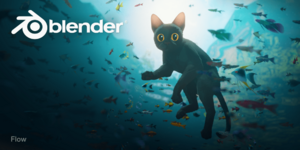
Blender started as a tool for an animation company. It was used in the film Spider-Man 2 for early animations.
The film Friday or Another Day was the first feature film to use Blender for all its special effects. It won an award at a film festival.
The Secret of Kells, an Oscar-nominated film, was partly made with Blender. Blender has also been used for shows on the History Channel.
Plumíferos, a full-length animated film, was made entirely in Blender. Special effects for Red Dwarf season X were also created using Blender.
Blender was used for pre-visualizations in Captain America: The Winter Soldier. Some art for Super Smash Bros. for Nintendo 3DS and Wii U was also made with Blender.
The music group Death Grips used Blender for music videos. The TV series The Man in the High Castle used Blender for visual effects.
NASA uses Blender to create interactive web apps. For example, they made an app to explore the Curiosity rover on Mars. Many 3D models on NASA's website are in Blender's format.
The animated short film Alike (2015) used Blender as its main tool. Blender was also used for CGI in the movie Hardcore Henry.
Director David F. Sandberg used Blender for shots in Lights Out and Annabelle: Creation. Blender was used for parts of the credits in Wonder Woman.
The film Cinderella the Cat used Blender for animation. The 2018 film Next Gen was fully created in Blender.
The 2019 film I Lost My Body used Blender's Grease Pencil tool. This allowed artists to draw over 3D animation.
Ubisoft Animation Studio started using Blender in 2020. Khara and Project Studio Q are also moving to Blender.
The 2020 film Wolfwalkers and the 2021 Netflix show Maya and the Three were partly made with Blender.
VFX company Makuta VFX used Blender for the film RRR.
Blender was used in the 2023 film Spider-Man: Across the Spider-Verse. Sony Pictures Imageworks used Blender's Grease Pencil. A fan animator also used Blender for a Lego scene in the film.
The 2024 Latvian film Flow was made entirely in Blender. It won an Academy Award for Best Animated Feature.
Blender in Schools and Research
Because Blender is free and open-source, it's used a lot in schools. Universities like the University of Michigan use it to teach 3D art and animation. Blender is also used in research to create images for computer vision and AI training.
Blender's Creative Projects
Since 2005, the Blender Foundation has started creative projects. These projects help improve Blender. They have made films like Elephants Dream, Big Buck Bunny, Sintel, and Tears of Steel. They also made a game called Yo Frankie!.
Blender Online Services
Blender Foundation Services
Blender Studio
Blender Studio is an online platform. Members can get Blender add-ons and courses. They can also follow the making of Blender Studio's open movies. It started in 2014 as Blender Cloud. It helps fund Blender's development.
The Blender Development Fund
The Blender Development Fund is a way to support Blender's development. Individuals and companies can donate money. Big companies like Epic Games, Nvidia, and Microsoft contribute.
Blender ID
The Blender ID is one login for all Blender services. You can use it for Blender Studio, the Blender Store, and more.
Blender Open Data
Blender Open Data collects and shows benchmark data. This data comes from the Blender community using the Blender Benchmark software.
Blender Store
The Blender Store sells Blender merchandise. You can buy shirts, socks, and other items.
Blender Extensions
Blender Extensions is where you can find add-ons and themes. You can install and update them directly in Blender.
Blender's Release History
This table shows important updates in Blender's history. Green means the current version, yellow means supported versions, and red means older versions.
| Version | Release date | Notes and key changes |
|---|---|---|
| 1.00 | January 1994 | Blender in development. |
| 1.23 | January 1998 | SGI version released. |
| 1.30 | April 1998 | Linux and FreeBSD version. |
| 1.4x | September 1998 | Sun and Linux Alpha version released. |
| 1.50 | November 1998 | First Manual published. |
| 1.60 | April 1999 | New features behind a $95 lock. Windows version released. |
| 1.6x | June 1999 | BeOS and PPC version released. |
| 1.80 | June 2000 | Blender freeware again. |
| 2.00 | August 2000 | Interactive 3D and real-time engine. |
| 2.03 | 2000 | Handbook The official Blender 2.0 guide. |
| 2.10 | December 2000 | New engine, physics, and Python. |
| 2.20 | August 2001 | Character animation system. |
| 2.21 | October 2001 | Blender Publisher launch. |
| 2.2x | December 2001 | Apple macOS version. |
| 2.25 | October 13, 2002 | Blender Publisher freely available. |
| 2.26 | February 2003 | The first truly open source Blender release. |
| 2.30 | November 22, 2003 | New GUI; edits are now reversible. |
| 2.32 | February 3, 2004 | Ray tracing in internal renderer; support for YafaRay. |
| 2.34 | August 5, 2004 | LSCM-UV-Unwrapping, object-particle interaction. |
| 2.37 | May 31, 2005 | Simulation of elastic surfaces; improved subdivision surface. |
| 2.40 | December 22, 2005 | Greatly improved system and character animations (with a non-linear editing tool), and added a fluid and hair simulator. New functionality was based on Google Summer of Code 2005. |
| 2.41 | January 25, 2006 | Improvements of the game engine (programmable vertex and pixel shaders, using Blender materials, split-screen mode, improvements to the physics engine), improved UV mapping, recording of the Python scripts for sculpture or sculpture works with the help of grid or mesh (mesh sculpting) and set-chaining models. |
| 2.42 | July 14, 2006 | The film Elephants Dream resulted in high development as a necessity. In particular, the Node-System (Material- and Compositor) has been implemented. |
| 2.43 | February 16, 2007 | Sculpt-Modeling as a result of Google Summer of Code 2006. |
| 2.46 | May 19, 2008 | With the production of Big Buck Bunny, Blender gained the ability to produce grass quickly and efficiently. |
| 2.48 | October 14, 2008 | Due to development of Yo Frankie!, the game engine was improved substantially. |
| 2.49 | June 13, 2009 | New window and file manager, new interface, new Python API, and new animation system. |
| 2.57 | April 13, 2011 | First official stable release of 2.5 branch: new interface, new window manager and rewritten event — and tool — file processing system, new animation system (each setting can be animated now), and new Python API. |
| 2.58 | June 22, 2011 | New features, such as the addition of the warp modifier and render baking. Improvements in sculpting. |
| 2.58a | July 4, 2011 | Some bug fixes, along with small extensions in GUI and Python interface. |
| 2.59 | August 13, 2011 | 3D mouse support. |
| 2.60 | October 19, 2011 | Developer branches integrated into the main developer branch: among other things, B-mesh, a new rendering/shading system, NURBS, to name a few, directly from Google Summer of Code. |
| 2.61 | December 14, 2011 | New Render Engine, Cycles, added alongside Blender Internal (as a "preview release"). Motion Tracking, Dynamic Paint, and Ocean Simulator. |
| 2.62 | February 16, 2012 | Motion tracking improvement, further expansion of UV tools, and remesh modifier. Cycles render engine updates to make it more production-ready. |
| 2.63 | April 27, 2012 | Bug fixes, B-mesh project: completely new mesh system with n-corners, plus new tools: dissolve, inset, bridge, vertex slide, vertex connect, and bevel. |
| 2.64 | October 3, 2012 | Green screen keying, node-based compositing. |
| 2.65 | December 10, 2012 | Over 200 bug fixes, support for the Open Shading Language, and fire simulation. |
| 2.66 | February 21, 2013 | Rigid body simulation available outside of the game engine, dynamic topology sculpting, hair rendering now supported in Cycles. |
| 2.67 | May 7–30, 2013 | Freestyle rendering mode for non-photographic rendering, subsurface scattering support added the motion tracking solver is made more accurate and faster, and an add-on for 3D printing now comes bundled. |
| 2.68 | July 18, 2013 | Rendering performance is improved for CPUs and GPUs, support for Nvidia Tesla K20, GTX Titan and GTX 780 GPUs. Smoke rendering improved to reduce blockiness. |
| 2.69 | October 31, 2013 | Motion tracking now supports plane tracking, and hair rendering has been improved. |
| 2.70 | March 19, 2014 | Initial support for volume rendering and small improvements to the user interface. |
| 2.71 | June 26, 2014 | Support for baking in Cycles and volume rendering branched path tracing now renders faster. |
| 2.72 | October 4, 2014 | Volume rendering for GPUs, more features for sculpting and painting. |
| 2.73 | January 8, 2015 | New fullscreen mode, improved Pie Menus, 3D View can now display the world background. |
| 2.74 | March 31, 2015 | Cycles got several precision, noise, speed, memory improvements, and a new Pointiness attribute. |
| 2.75a | July 1, 2015 | Blender now supports a fully integrated Multi-View and Stereo 3D pipeline, Cycles has much-awaited initial support for AMD GPUs, and a new Light Portals feature. |
| 2.76b | November 3, 2015 | Cycles volume density render, Pixar OpenSubdiv mesh subdivision library, node inserting, and video editing tools. |
| 2.77a | April 6, 2016 | Improvements to Cycles, new features for the Grease Pencil, more support for OpenVDB, updated Python library and support for Windows XP has been removed. |
| 2.78c | February 28, 2017 | Spherical stereo rendering for virtual reality, Grease Pencil improvements for 2D animations, Freehand curves drawing over surfaces, Bendy Bones, Micropolygon displacements, and Adaptive Subdivision. Cycles performance improvements. |
| 2.79b | September 11, 2017 | Cycles denoiser, improved OpenCL rendering support, Shadow Catcher, Principled BSDF Shader, Filmic color management, improved UI and Grease Pencil functionality, improvements in Alembic import and export, surface deformities modifier, better animation keyframing, simplified video encoding, Python additions and new add-ons. |
| 2.80 | July 30, 2019 | Revamped UI, added a dark theme, EEVEE realtime rendering engine on OpenGL, Principled shader, Workbench viewport, Grease Pencil 2D animation tool, multi-object editing, collections, GPU+CPU rendering, Rigify. |
| 2.81a | November 21, 2019 | OpenVDB voxel remesh, QuadriFlow remesh, transparent BSDF, brush curves preset in sculpting, WebM support. |
| 2.82 | February 14, 2020 | Improved fluid and smoke simulation (using Mantaflow), UDIM support, USD export and 2 new sculpting tools. |
| 2.83 LTS |
June 3, 2020 | Introduction of the Long Term Support (LTS) program, VDB files support, VR scene inspection, new cloth sculpt brush and viewport denoising. |
| 2.90 | August 31, 2020 | Physically based Nishita Sky Texture, improved EEVEE motion blur, sculpting improvements including a new multiresolution modifier and modelling improvements. |
| 2.91 | November 25, 2020 | Cloth Brush improvements, new sculpting Trim tool, new mesh boolean solver, volume to mesh and mesh to volume modifiers and customisable curve bevels. |
| 2.92 | February 25, 2021 | New Geometry Nodes procedural modelling system, New interactive Add Primitive Tool, sculpting improvements and Grease Pencil improvements. |
| 2.93 LTS |
June 2, 2021 | Expansion of Geometry Nodes with mesh primitives and a new spreadsheet editor, sculpting improvements, new grease pencil line art modifier and EEVEE rendering improvements. |
| 3.0 | December 3, 2021 | Major Cycles update with rewritten GPU kernels and rewritten shadow catchers and other rendering improvements. Overhaul to Geometry nodes with new 'Fields' system. A new UI visual refresh as well as other features and improvements. |
| 3.1 | March 9, 2022 | Point cloud objects, Cycles Metal Backend and new geometry nodes. |
| 3.2 | June 8, 2022 | Cycles light groups, shadow caustics rendering, sculpt mode painting and collection support in the asset browser. |
| 3.3 LTS |
September 7, 2022 | New procedural hair system with geometry nodes, support for Intel Arc GPUs and new geometry nodes. |
| 3.4 | December 7, 2022 | Path Guiding in Cycles, auto masking in sculpt mode, new UV relax tool and new geometry nodes. |
| 3.5 | March 29, 2023 | New hair system with Geometry nodes and asset browser, real-time viewport compositor, vector displacement maps for sculpting, viewport performance improvements with Apple Metal. |
| 3.6 LTS |
June 27, 2023 | Simulation Nodes, rendering performance improvements on AMD Hardware and better UV packing. |
| 4.0 | November 14, 2023 | Cycles light linking, improved Principled BSDF shader, better Color management with the AgX tone mapper, and Geometry Nodes improvements. |
| 4.1 | March 26, 2024 | Geometry nodes baking, OpenImageDenoise performance improvements and viewport compositor improvements. |
| 4.2 LTS |
July 16, 2024 | Rewrite of the EEVEE render engine to be closer to cycles (called EEVEE Next), addition of Ray Portal BSDF in Cycles, addition of Khronos PBR Neutral tone mapping, and GPU acceleration for the compositor. |
| 4.3 | November 19, 2024 | Multi-pass compositing support for EEVEE, hardware accelerated ray tracing support for Linux, geometry node support for grease pencil. |
| 4.4 | March 18, 2025. | "Slotted" actions, Vastly Superior Editing (VSE) and support for 10-bit and 12-bit videos. |
| 4.5 LTS |
July 15, 2025. | Full Vulkan support. |
| 5.0 | November 11, 2025. | This version is currently under development. |
|
Legend:
Old version
Older version, still maintained
Latest version
Latest preview version
Future release
|
||
Blender is available for Windows, macOS, and Linux. It runs on 64-bit systems. Blender 4.5 LTS was the last version to support macOS Intel.
More to Explore
- Andrew Price – The Blender Guru
- List of free and open-source software packages
- List of video editing software
- List of 3D printing software
See also
 In Spanish: Blender para niños
In Spanish: Blender para niños


